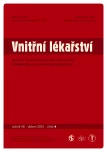Specific diabetes education in children
Authors:
J. Venháčová
Authors‘ workplace:
Dětská klinika Lékařské fakulty UP a FN Olomouc, přednosta prof. MUDr. Vladimír Mihál, CSc.
Published in:
Vnitř Lék 2012; 58(4): 309-312
Category:
Reviews
Overview
Education is an integral part of diabetes care. The structured self-management education is the key to improve glycemic control, to reduce the risk of acute and long term complications and it is associated with improved quality of life. Type 1 is the most common type of diabetes in children and adolescents. Although the basic treatment principles are the same as in adults, the developmental characteristics during childhood need to apply age-appropriate, different teaching and learning techniques that should be adaptable to individual abilities, skills, needs and requirements of patients and parents, as well.
Key words:
diabetes mellitus type 1 – education – specifities in children and adolescents – glycemic control criteria
Sources
1. Northam EA, Todd S, Cameron FJ. Interventions to promote optimal health outcomes in children with type 1 diabetes – are they effective? Diabet Med 2006; 23: 113–121.
2. Ginsburg KR, Howe CJ, Jawa AF et al. Parents’ Perceptions on Factors that Affect Successful Diabetes Management for Their Children. Pediatrics 2005; 116: 1095–1104.
3. Cohen DM, Lumley MA, Naar-King S et al. Child Behavior Problems and Family Functioning as Predictors of Adherence and Glycemic Control in Economically Disadvantaged Children with Type 1 Diabetes: A Prospective Study. J Pediatr Psychol 2004; 29: 171–184.
4. Anderson BJ. Parenting Styles and Parenting Practices in Pediatric Diabetes. Diabetes Care 2011; 34: 1885–1886.
5. Cameron FJ, Skinner TC, de Beaufort CE et al. Hvidoere Study Group on Childhood Diabetes. Are family factors universally related to metabolic outcomes in adolescents with Type 1 diabetes? Diabet Med 2008; 25: 463–468.
6. Lebl J, Průhová Š, Šumník Z et al. Abeceda diabetu. Praha: Maxdorf 2008.
7. Lange K, Sassmann H, von Schülz W et al. Prerequisites for age-appropriate education in type 1 diabetes: a model programme for paediatric diabetes education in Germany. Pediatr Diabetes 2007; 8 (Suppl 6): 63–71.
8. Swift PGF. Diabetes education in children and adolescents. ISPAD Clinical Practice Consensus Guidelines 2009 Compendium. Pediatr Diabetes 2009; 10 (Suppl 12): 51–57.
9. Grey M, Boland EA, Davidson M et al. Coping skills training for youth with diabetes mellitus has long-lasting effects on metabolic control and quality of life. J Pediatr 2000; 137: 107–113.
10. Court JM, Cameron FJ, Berg-Kelly K et al. Diabetes in Adolescence. ISPAD Clinical Practice Consensus Guidelines 2009 Compendium. Pediatric Diabetes 2009; 10 (Suppl 12): 185–194.
11. Wolfsdorf J, Glaser N, Sperling MA. American Diabetes Association. Diabetic Ketoacidosis in Infants, Children, and Adolescents. A consensus statement from the American Diabetes Association. Diabetes Care 2006; 29: 1150–1159.
12. Martínez-Aguayo A, Araneda JC, Fernandez D et al. Tobacco, alcohol, and illicit drug use in adolescents with diabetes mellitus. Pediatr Diabetes 2007; 8: 265–271.
13. Wysocki T, Harris MA, Buckloh LM et al. Effects of Behavioral Family Systems Therapy for Diabetes on Adolescents’ Family Relationships, Treatment Adherence and Metabolic Control. J Pediatr Psychol 2006; 31: 928–938.
14. Wysocki T, Harris MA, Buckloh LM et al. Randomised Trial of Behavioral Family Systems Therapy for Diabetes: maintenance of effects on diabetes outcomes in adolescents. Diabetes Care 2007; 30: 555–560.
15. Revers M, Pihoker C, Donaghue K et al. Assessment and monitoring of glycemic control in children and adolescents with diabetes. ISPAD Clinical Practice Consensus Guidelines 2009 Compendium. Pediatr Diabetes 2009; 10 (Suppl 12): 71–81.
16. Nyomba BL, Berard L, Murphy LJ. Facilitating access to glucometer reagents increases blood glucose self-monitoring frequency and improves glycaemic control: a prospective study in insulin-treated diabetic patients. Diabet Med 2003; 21: 129–135.
17. Levine BS, Anderson BJ, Butler DA et al. Predictors of glycemic control and short-term adverse outcomes in youth with type 1 diabetes. J Pediatr 2001; 139: 197–203.
18. McAndrew L, Schneider SH, Burns E et al. Does Patient Blood Glucose Monitoring Improve Diabetes Control? A Systematic Review of the literature. Diabetes Educ 2007; 33: 991–1010.
19. Helgeson VS, Honcharuk E, Becker D et al. A focus on blood glucose monitoring: relation to glycemic control and determinants of frequency. Pediatr Diabetes 2011; 12: 25–30.
20. Ziegler R, Heidtmann B, Hilgard D et al. DPV-Wiss-Initiative. Frequency of SMBG correlates with HbA1c and acute complications in children and adolescents with type 1 diabetes. Pediatr Diabetes 2011; 12: 11–17.
Labels
Diabetology Endocrinology Internal medicineArticle was published in
Internal Medicine

2012 Issue 4
Most read in this issue
- Pervitin induced acute myocardial infarction
- The importance of NGAL and cystatin C biomarkers in cardiovascular diseases
- Acute copper poisoning by suicidal attempt
- New knowledge of the pathogenesis of Crohn’s disease
